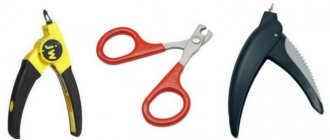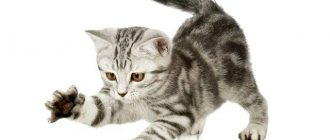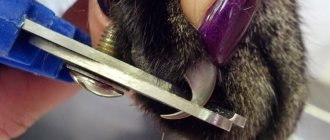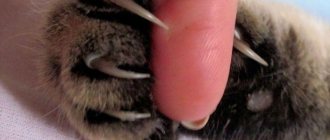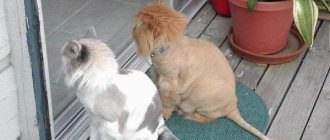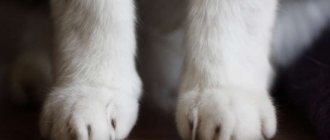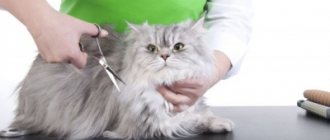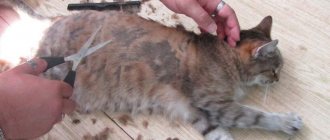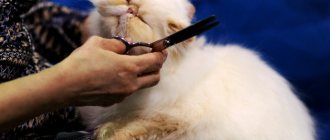How to properly trim a cat's claws: methods at home
If your cat won’t let you cut her nails, you can try to accustom her to this procedure gradually, the main thing is to be patient.
Try a few simple tricks:
- If your cat doesn’t have enough patience for a long time, start small. To begin with: cut two claws and release the pet, not forgetting to praise. Then cut off more, and increase the number of toes until you have processed all the paws.
- Wait until the cat has no desire to resist when she has eaten and becomes sleepy.
- Try trimming nails while your cat is sleeping.
- If your cat becomes stressed due to the procedure, you can try giving him sedatives using natural herbs, for example, “Cat Bayun”.
- If you catch a kitten in a playful mood, you should postpone claw trimming until the kitten becomes less agitated.
The process of training and recommendations: what to do if it doesn’t work?
When a small kitten appears in the house, you need to immediately think about trimming its claws. It is important to do this from childhood, so that as your pet grows up it will not be afraid of unfamiliar tools.
The procedure is carried out only when the cat is in a good mood and is being caressed.
At first she will walk away and pull her paws away - there is no need to interfere. Accustoming is required gradually, without resorting to violence.
When your pet allows you to pet his paw pads, you need to give him a treat. After a while, the kitten will like this massage, and he will expose his claws himself.
Nail trimming depending on breed
At what age are British cats neutered?
Veterinarians say that the condition of the nails and the rate of their growth directly depends on the specific breed of the animal. And this factor influences the cutting process. Persian cats often experience delamination of the horny area and rapid growth of claws. Therefore, experts advise carrying out the procedure for this breed several times a month. The condition of the nails is also affected by the age of the pet. In mature years, an abnormal growth of the claws sometimes occurs. Because of this, it is recommended to trim them only under the supervision of a specialist. Additionally, a change in diet may be prescribed to strengthen the nails.
Based on these features, it is worth considering the procedure based on the characteristics of the animal’s breed.
Claw clippers
Haircut for the sphinx
The Thai Sphynx's claws grow quite quickly. And the main feature is the frequency of the procedure. You will have to cut off the claws several times a month. The process consists of several steps:
you need to choose the right moment. It is best when the animal is a little tired and about to fall asleep. It is difficult for a pet in this state to actively resist; he will be relaxed. You need to handle it calmly, without sharp or loud sounds; a suitable place with good lighting is selected in advance. It is necessary to place everything that is required in the process there.
Of course, it is important to act carefully so as not to injure your paws. But just in case, it’s worth keeping hydrogen peroxide nearby to treat wounds; Sphinx sits on her owner's lap
Gently press on the pads of the paws so that the claws appear
In good lighting, the border where the vessels begin is clearly visible. Only white areas can be removed. Anything that has a pink tint should not be touched; At an angle of 90 degrees, a small part of the nail is removed with the selected tool.
Gently press on the pads of the paws so that the claws appear. In good lighting, the border where the vessels begin is clearly visible. Only white areas can be removed. Anything that has a pink tint should not be touched; At an angle of 90 degrees, a small part of the nail is removed with the selected tool.
Reference! If the plate begins to peel, you should carefully file it with a file and remove it.
If it was not possible to avoid injury and blood appears, it is recommended to apply a piece of cloth or cotton wool soaked in peroxide
If bleeding is severe, it is important to contact your veterinarian promptly.
Trimming a Brit's nails
And others
A British cat needs to have the procedure done every 3 weeks. You should also inspect the animal's claws. Each pet is individual and some representatives of the British breed may have slower nail growth. Therefore, trimming will need to be done once a month.
Owners of Scots are lucky in that representatives of this breed are intelligent. Therefore, problems with training to carry out hygienic procedures rarely arise. The claws of the Scots are quite transparent and the border between the blood vessels and dead areas is clearly visible. This makes the cutting process easier.
CUT YOUR CLAWS
Trimming the claws of a Sphynx kitten is stressful, first of all, for an inexperienced owner!
Therefore, prepare for the process in advance. Otherwise, the baby will simply hide and be right! In order not to make yourself nervous and not to make your kitty nervous, follow very simple rules for trimming claws. First, a few words:
— firstly, we recommend that new “parents” of a Sphynx kitten remember that this procedure has been performed with the baby several times in the nursery and the kitten is familiar with it (trimming its claws)! - secondly, if a child does not give you a paw for trimming his nails - THINK! -Are you doing everything right now? Maybe you squeezed the paw or the baby too tightly? - thirdly, just follow all the rules for carrying out this simple procedure, having previously purchased special scissors for trimming claws at a pet store.
INSTRUCTIONS FOR CUTING NAILS
Choose a time when the kitten has had enough of playing, is full, tired and wants to sleep. At this time, he will be most relaxed and least inclined to resist. While trimming his nails, you can talk to him in a calm voice. It is necessary to find a well-lit place and prepare there everything necessary for the nail trimming procedure. In case of a cut, have a bottle of hydrogen peroxide ready or just try to be very careful. Pick up the kitten and place it on your lap. Take your baby's paw and gently press on the pads so that the claws show their full length. Hold the claw up to the light. In good lighting, the boundaries of the claw and blood vessels are clearly visible. What can be cut will be white, what cannot be cut will be pink. Everything is exactly the same as with little children! If you cut a nail more than it should, it will hurt your baby and blood will flow from the nail. Be careful: it is better to trim less than to injure the kitten!
Using special nail clippers, bite off the edge of the white nail at a 90° angle, leaving 1.5-2 mm before the beginning of the pink tissue. If the claw is separated, remove the unnecessary plate.
In kittens, the claw tissue is quite soft and claw trimming is not a painful procedure for them. However, the claw must be cut strictly perpendicular to the surface of the claw.
If bleeding does occur, it can be quickly stopped using a styptic pencil; You can also attach a piece of cloth or sprinkle with flour. Often, pressing a claw into a bar of soap is enough to stop mild bleeding. If bleeding is severe, apply a pressure bandage and contact your veterinarian.
Source
Step-by-step instructions for trimming nails
Step 1. Wash your hands and rinse them and the nail clipper with a disinfectant solution.
Step 2. Prepare a disinfectant solution and cotton wool in case you accidentally hit a blood vessel.
Step 3. Catch the animal when it is inactive and in a good mood. Talk to him kindly.
Step 4. Sit in a comfortable position. For example, place the cat on your lap. You need to hold your paw confidently, because you don’t want the animal to twitch at the most inopportune moment - and you cut off the excess. Some pets resist the procedure very desperately and you have to carry it out together, also holding those paws that are not currently involved.
Step 5. To expose the claw, you need to hold the entire paw and press separately on the pad to which it belongs. During the process of trimming the claw, the pad must be kept pressed.
Step 6: Apply scissors or a guillotine to the claw in the correct location (as described above) at a 90 degree angle, approximately 3mm away from the blood vessels. If you are afraid, you can leave more the first time, then the claw will simply grow back faster. Cut with one but confident movement, without cutting or “chewing” the claw.
At what age should you start trimming your nails?
Nowadays there is a widespread opinion that the sooner you accustom your cat to the procedure of claw trimming, the better. This is partly true, but only partly. It is completely pointless to approach kittens that are two or three months old with special scissors. Their claws simply haven’t had time to form yet.
The soft claws of very young kittens do not need correction
An analogy can be drawn with teeth - there is no point in going to pull out baby teeth, since they will fall out on their own and make room for new ones. Of course, kittens’ claws will not grow, but during the first months they are renewed without anyone’s intervention due to their softness. By the first two months, only the first “hints” of keratinized epidermis form on the kittens’ paws. It makes sense to correct it only if there is a risk of injury to the kitten, which occurs very rarely.
You should start thinking about trimming nails when your pet reaches six months of age.
Closer to six months, when the kitten’s body gradually takes on its final shape, and the body gradually completes active development, it makes sense to take up the scissors and accustom the “young people” to this difficult procedure. Trying to trim nails too early will not necessarily lead to quick habituation. On the contrary, if you are careless and damage your kitten’s already fragile claw, he will remember this for a long time.
How to trim a kitten's claws?
- Catch the moment when the kitten has had enough of playing, running around and is now about to go to bed. This is when he is most relaxed and receptive. If you pick up a kitten at the peak of its game, it will begin to break out in every possible way;
- Throughout the procedure, talk to the kitten in a quiet and calm voice. Kittens do not understand human words, but they perfectly catch intonations. Nervousness in the head or haste will be transmitted to your pet as quickly as calmness and confidence;
- Do not start the procedure right away. Hold the kitten in your arms and let him get used to this position; Remember that he must feel that you are not going to hurt him;
- Using your index and middle fingers, gently press the pad so that the kitten releases its claw. Examine it and determine exactly how you will hold the nail clipper so as not to injure the animal;
- Place the nail cutter from top to bottom so that it is perpendicular to the claw being trimmed and trim the claw at a distance of one or two millimeters to the pulp (it has a pinkish tint);
- If it turns out that you cut off an extra part of the claw and a little bleeding begins, do not panic. Use hydrogen peroxide to treat the wound and prevent bacteria from entering;
- If you see that you did not cut your nail very neatly, use a special nail file to correct the situation. But do not try to grind off too much of the epidermis - the kitten will immediately feel pain and begin to struggle;
- Reward the kitten for the “feat” he has experienced with his favorite treat.
Keep in mind that the first time, the kitten may simply not be able to wait until the end of the procedure and begin to struggle. Few adult cats can sit until the end without moving, let alone young, full of energy kittens. You can start by treating one paw at a time, then gradually move on to two, and so on.
It is advisable to start the procedure with a positive attitude from both the cat and the owner.
When trimming nails, it is important to adapt to your pet’s mood. If he breaks free and wants to run away, let him do it. This is probably due to poor use of a nail clipper and touching the sensitive part of the claw.
Perhaps you've come across a hyperactive cat who can't sit still for more than a minute. Situations are different - the main thing is to choose the right approach in time
This is probably due to poor use of the nail clipper and touching the sensitive part of the claw. Perhaps you've come across a hyperactive cat who can't sit still for more than a minute. Situations are different - the main thing is to choose the right approach in time.
Why is the procedure needed?
It is clear that yard cats do not have a problem with cutting their claws, since they wear down naturally when the animal’s paws actively come into contact with any surface or cling to the bark of trees when climbing on them. Thus, small keratinized parts spontaneously fall off. For domestic cats, wonderful accessories have been invented in the form of scratching posts, on which pets can do a home manicure.
A mandatory hygienic procedure for caring for claws is their timely trimming. Pay attention to the toes of the front and rear paws - they have four toes. Now return to the forelimbs, their structure is slightly different, and a little higher you will find another finger. It is these lateral claws that are not worn down when walking and can cause trouble in the form of ingrowth, which creates discomfort for the animal. This is where the owner’s help will be needed in the correct ability to trim and process the tips of the claws.
>Video “How to trim a cat’s claws”
In this video you will learn how to properly trim a cat's claws.
How often and at what age to cut your hair?
Kittens are born with claws. It is not recommended to circumcise a kitten before 4 weeks of age; 2-3 months is considered the optimal age. Hooks help the baby learn to walk, climb, and not fly into a ditch when turning. Breeders accustom kittens to scratching posts from birth.
If the cat is domestic and very actively scratches the scratching post, then it is not necessary to trim it. Every week you need to monitor the condition of your cat's manicure. The claws on the hind paws grow more slowly than those on the front paws, and they are trimmed less often.
To avoid flakiness, the cat does not get out of the habit of the procedure, treats it calmly, it should be trimmed once every 2-3 weeks.
How often should you trim your nails?
The number of procedures for cutting claws varies, and this is not surprising - the characteristics of each cat’s body are individual. For one cat, it is enough to trim its claws once a month; for another, the treatment will need to be repeated three or even four times. Be guided as the claws grow. If the cat is accustomed to a scratching post, then she will naturally partially grind off her claws, which will prolong the effect of trimming. And if you haven’t managed to develop such a useful habit yet, you can read our effective tips for teaching a scratching post.
As a rule, the more often you trim your nails, the better, even if you trim just a little at a time. By trimming its claws too infrequently and with slow growth, the cat will have time to wean itself off the necessary procedure, and you will have to retrain it.
Claw care is especially important for cats attending exhibitions. For them, cutting nails is not only a hygienic procedure, but also a cosmetic one, since all exhibition animals must not only be healthy, but also look impeccable.
Do all cats need to have their nails trimmed?
You should get a manicure if your cat is an indoor cat and does not go outside. When your pet walks in the fresh air or visits a dacha, you cannot cut its nails. A free-range animal wears down the tips of its claws while climbing trees or running on asphalt. Cats need them for defense against enemies; without them the animal is defenseless. Veterinarians do not encourage this procedure, especially if the pet is healthy. However, in some situations you need to do this:
- When an animal behaves aggressively, it is very dangerous for small children.
- Scratches walls, furniture, doors in the apartment.
- Clings to floor coverings and soft blankets, risking injury.
Under no circumstances should you trim the claws of a pregnant cat, as this can cause premature birth. If a small kitten has settled in the house, it is advisable to accustom it to the procedure from an early age. The baby hisses and bites - then you should postpone the lesson and repeat it later. The need for nail trimming may depend on the breed, for example, Sphynxes and Persians sometimes have specific problems.
In Persian cats, keratinized growths often grow and peel off. This occurs due to a deficiency of vitamins B and D in the body. Hair mats (mats) also form between the fingers, which need to be cut. The Scottish Fold breed often suffers from claw abnormalities, which needs to be carefully monitored and trimmed in a timely manner. If you don’t do this, your pet may get caught and pull out the claw completely. Also, during play, a cat can injure a person or other animal.
Nothing can replace the love of their owner for our pets. They trust us with their health and life. Let's make the stay of furry pets near us safe and calm. After all, our life becomes much more interesting with cats.
Do you need to cut your cat's nails?
If a cat spoils furniture, does not want to use a scratcher, shows aggression towards people, or its claws do not grow properly (this happens quite often), then it is better to trim them.
Sometimes, even while playing with the owner, the cat cannot control the dangerous weapon, clinging to surrounding objects and injuring the person, risking simultaneously injuring himself.
If there are several cats in the house, they are constantly running around, fighting, injuring each other, you should trim their claws.
Anatomy of claws
A cat's claw is a complex system consisting of muscles, joints, tendons and ligaments. This allows the animal to release it and hide it again.
The visible part of the claw consists of 2 parts: the cornea and the pulp - the living part with blood vessels and nerve endings. Only the upper cornea can be cut off; touching the pulp is strictly prohibited. To do this, it is enough to remove only 2 mm of the tip of the claw.
Periodically, the old layer in the form of a cover is removed from the claws. The fifth claw on the front paws is located on the back side and is never worn down. Over time, it can curl up and grow into the skin.
In what cases is it necessary to cut your hair?
When a pet lives in the house and does not go outside, it does not need protection
He has everything for a comfortable life - housing, food, water, attention. In this regard, the most dangerous weapon of a cat is often used for other purposes, causing harm
A strongly overgrown claw bends and hurts the pads of the cat's toes when walking. Breeders are recommended to introduce kittens to nippers from childhood, then problems will not arise in the future.
If the cat is an adult, and the claws need to be trimmed for the first time, you need to be patient to accustom him to grooming. Regular pruning does not require complex skills and it is quite possible to do the procedure yourself at home.
Anomalies: detachments, bifurcation of the claw
When there are no irregularities in the pet’s diet and the claws are cut when necessary, a scratching post is placed in the house, but the claws continue to split or bifurcate - this is a reason to worry about the health of the animal. If a cat periodically limps and does not allow its paws to be touched, this indicates defeat.
In case of injury or improper pruning, infection can penetrate into the soft tissue. This inflammation is called paronychia, and when suppuration forms, it is called pyongychia. In this situation, the most correct decision is to visit a veterinarian in order to:
- getting your pet tested;
- making an accurate diagnosis and prescribing treatment.
Often, an infectious lesion requires a course of antibiotics, or even an operation - opening and draining the infected wound, removing the claw.
Another reason for nail splitting is their abnormal growth. As a rule, this happens in old animals when the thyroid gland produces too many hormones.
Pathologies should also include fungi. They arise under the influence of injury or improper haircut. The main signs of fungal infection:
- unnatural color;
- compaction and thickening;
- swelling and hyperemia around;
- pain in the paw, causing the cat to limp;
- The cat often licks and bites his paw.
What to do if the claw is in the way?
If the owner constantly notices the cat’s discomfort when claws cling to the carpet, upholstered furniture, etc., you need to check the pet’s claws. Perhaps this is a sign of their excessive growth and the need for trimming.
Other reasons
There are other reasons for trimming a cat's claws. For example, a pet damages furniture and shoes, does not respond to scratches, and can scratch the owner or other residents of the apartment, especially if there are small children in the house.
If nails grow abnormally, trimming them is necessary.
What's special about a cat's claws?
Cat claws are sickle-shaped, with sharp, curved tips. Looking at them, we can say with confidence: they were created by nature as a means of survival in the wild environment. After all, it is the sharp claws that help the cat hold its prey in its paws, deftly climb trees, attack and defend itself from enemies.
On the outside, the claw processes are covered with a hard layer of epidermis, which includes keratin. Inside there are soft pulp tissues, including nerve endings and capillary plexuses. Thanks to the presence of a system of ligaments and tendons, the claws can retract without interfering with walking (which is why the purr's step is insinuating and inaudible). But, if necessary, the claws instantly appear from the folds of the skin, and the enemy is convinced that the opponent is fully armed.
In addition, there are special glands on the paw pads that secrete secretions containing pheromones. By scratching tree trunks, the cat leaves marks on them, thereby marking the boundaries of its territory. The terminal phalanges of the toes, together with the claws, are involved in the formation of a cat's gait (cats have the peculiarity of stepping not on the entire foot, but only on the toes).
How to trim your pet's nails at home?
It is recommended to cut a kitten's claws from two or three months of age. Small pets have soft nails that are easier to trim. In addition, if you accustom your pet to hygiene procedures from childhood, there will be no problems with performing the procedure in the future. At the same time, sometimes there are cats that have a negative attitude towards manipulation at any age.
Preparation for the procedure
To trim your cat's nails at home, you need to choose a time when she will be calm. It's good if the pet is sleepy and peaceful. It is not recommended to “catch” your pet during play; this will create additional problems.
Before the procedure, you need to establish emotional contact with your pet. To do this, you need to stroke the cat's paws, moving to the pads. When light pressure is applied to the paw pads, claws will appear. This exercise should be performed not only before cutting your nails, but also in everyday life. The cat should get used to this kind of touch.
Required Tools
Before trimming your pet's claws, you should prepare tools and accessories. They should be at arm's length so that the owner is not distracted and does not make the cat nervous. If the procedure is being carried out for the first time, it is better to stock up on a whole set of tools. Each of them must be well sharpened so as not to cause splitting of the nails. You can trim your cat's nails using the following accessories:
- regular scissors;
- nail scissors;
- nail clippers;
- Guillon trimmer;
- blister (scissors for cats).
Most cat owners prefer to use pet-specific tools. The most common devices are sickle and guillotine nail clippers (see photo). The first ones are designed for trimming very strong claws. The latter are more versatile and convenient. Using a guillotine you can achieve a better, “clean” cut.
In addition to the basic tools, you need to prepare a hair clipper, cotton swabs, hydrogen peroxide or chlorhexidine solution, a manicure file/emery block, and a small towel. The file is useful for filing sections of claws. Cotton wool, hydrogen peroxide and a towel will be needed for possible damage to the paw.
Review of flea and tick shampoos for kittens and adult cats: which one is better, how do anti-flea detergents work?
Basic Rules
The manipulation should be carried out at home in a well-lit place, preferably near a window, so that the claws can be clearly seen. Before starting the procedure, you must treat the instruments with an alcohol solution and wash your hands thoroughly. Then you should sit the cat on your lap and stroke its back. Step-by-step instructions for trimming nails:
- lightly press the pad so that the claws appear;
- take a nail clipper with the other hand and cut off the claws one by one in one motion;
- do the same with the other paws;
- lightly file the nail plate, then treat the sections with an antiseptic solution.
If hair has grown between the toes, it is removed with a special machine. You can only cut off the nail plate by 1-2 mm. Inside the claw there are soft tissues consisting of nerve endings and blood vessels. Together they form a pulp, which, if damaged, can cause bleeding and the animal will experience severe pain. After unsuccessful manipulation, the cat may limp for several days. If the instruments have not been properly processed, an infection can penetrate into the soft tissues, which is dangerous for the pet’s health.
An adult animal's nails should be trimmed monthly. Kittens need manipulation twice as often. In any case, you should take into account the individual characteristics of the animal and perform the procedure as necessary. After trimming the claws, you can treat your pet with a treat, praise it for its patience, and cuddle it.
What to do if damaged?
If the cat has a negative attitude towards the procedure, there is a high probability of causing damage to it with manicure tools.
In case of bleeding, it is necessary to treat the wound with an antiseptic (iodine, hydrogen peroxide, horhexidine), sprinkle with talcum powder and carefully bandage the paw. You need to try to calm the animal by stroking its back and talking to it affectionately
If suppuration appears in the area of the wound or prolonged lameness or poor health of the cat, it is recommended to consult a veterinarian.
How to trim a kitten's claws - nail clippers and improvised tools?
Let's say you have an urgent need to give your pet a manicure. How to trim nails yourself without harming your pet? If you have a nail clipper, the task becomes easier. If the kitten is about to have its nails trimmed for the first time, and you don’t have the tools, you can use improvised media while observing safety precautions.
Important! Don't set yourself the task of trimming all of your kitten's nails at once. If you were able to cut one claw in one approach, this is already a success.
Regular scissors
The first thing that comes to the mind of an inexperienced owner is to trim the pet’s claws with ordinary scissors, but is this possible? Hypothetically, you can...if:
- The cat will not twitch.
- You have a steady hand.
- The cat has thin claws.
- You only need to trim the ends.
What could go wrong? The structure of a cat's claws is significantly different from that of a human. When using regular scissors to trim nails, there is a very high probability of:
- Crushing a claw is very painful.
- Injuring your finger if the cat pulls its paw is even more painful.
Have you injured your pet unknowingly? In such a situation, it is extremely important to quickly stop the bleeding and ensure that the wound does not become infected. The injured claw will grow back, after which it needs to be trimmed. If the wound looks serious or your finger is injured, it is best to consult a doctor. If you don’t have nail clippers at hand, and your claws urgently need to be shortened, it’s wiser to use a nail file or nail scissors.
Nail scissors
A small kitten (1-3 months old) can have its nails trimmed with nail scissors. The only nuance is the model of the scissors. Nail scissors can be distinguished by their tips:
- Curved - for cuticles.
- Direct.
- Rounded – safe for cutting off hangnails and corners of nails.
Nail scissors with rounded tips are suitable if the nails need to be blunted rather than trimmed. Simply put, if you only need to cut off the ends so that the baby does not cling to the bedding and injure himself, you can hold off on buying nail clippers.
Can nail clippers be used to trim nails?
Nail clippers (for humans) are one of the most common tools used by inexperienced owners to injure cats. To painlessly shorten your pet's claw, you need to cut it at an angle. The blades of the tweezers close straight, but in order to set them at the desired angle, the cat's paw will have to be bent at an unnatural angle.
Again, if your pet has an exceptionally calm temperament and lies motionless in any position during the procedure, tweezers are suitable. If the pet jerks its paw when the claw is caught between the blades, it will be injured. By the way, if you use tweezers, even veterinary ones, the pressure on the handles should be firm and sharp. By cutting the claw slowly and smoothly, you risk crushing it.
How to use a guillotine correctly
Have you bought nail clippers and don’t know how to use them? The good news is that the guillotine is easy to use and the procedure is safe. The second news is that you probably won’t be able to trim all the claws the first time.
First, check your pet's reaction by touching the guillotine to the claw. Click the claw clipper and watch the reaction again. If the cat does not pull back its paw, you can try cutting it. Be sure to hold your pet's paw with your free hand. Cut off only the tip (sharper) of the claw. Your movements should be confident and firm. The guillotine cuts the claw at an angle, so the pet should not experience any discomfort.
What tools can you use?
There are special nail clippers for trimming cat claws. It is not recommended to use nail scissors. They are designed for thin and flat nail plates of people. Such cutting tools lead to delamination.
There are several types of nail clippers:
- Blisters - resemble nail scissors, but have blades curved at the ends, designed for cat claws.
- Secateurs are equipped with a spring, which is located between the handles. As a rule, such models have a limiter. It allows you to cut only the desired length.
- Guillotines are similar to cigar scissors. The nail is placed in the hole at the end. When the handles are closed, the blade lowers and cuts the claw. The tool is suitable for cats with thick nail plates.
Each owner chooses the model that is convenient for him to use. The main thing is that it is made of high-quality materials and sharpened.
Additionally, you can buy an electric trimmer that allows you to quickly trim your nails. However, not all cats react calmly to it - the buzzing device scares the animals.
Haircutting tools
There are several types of devices that can be used to trim a cat’s claws:
- Guillotine claw clipper. The instrument has a ring at the end into which the keratinized part is placed. After pressing the handle, a blade appears and cuts off the fragment. The guillotine is more suitable for experienced breeders. Without the skill, it is easy to cut off an area larger than required.
- Nail clipper-secateurs. Looks like pliers. There is a spring between the handles, which greatly facilitates the process.
- Nail clipper-scissors. They resemble a human device, but with indentations on the cutting surface. The claw is placed in the notch and cut off. This design eliminates slipping and the risk of crumbling the plate. For trimming at home, this is the best option.
Stationery or manicure scissors, as well as wire cutters, cannot be used. They will crumble the plate.
Why you shouldn’t do onychotomy
Many owners, tired of problems with damaged furniture and torn walls, decide to take radical measures - onychectomy. There is definitely no need to do this!
Surgical intervention involving complete declawing is possible only for medical reasons, and not to satisfy the wishes and whims of the cat owner. “Soft paws” can solve the problem of property damage, but deprive the pet of natural protection and the necessary skills for living in a normal environment. They certainly make him flawed and cause irreparable harm to the psyche.
Even with positive results of the operation, after recovery, the pet will never be the same as before. Knowing this, it’s worth thinking: should you decide or not?
Fluffy four-legged pets decorate human life, but require care and attention. They have their own reflexes, natural instincts, which owners do not always like
When finally deciding to get a cat, it is important to remember: this is not a toy, but a living creature!
Preparing a cat for nail trimming
You need to accustom a kitten at 2-3 months, while the nails are soft; by the age of 6 months they harden. You can start trimming your nails at 3 months of age.
When training a cat, when playing and petting, gently stroke its paws, massage its pads, pressing so that claws appear. The baby will get used to such caresses and will not resist when you trim his nails.
Don't try to catch your cat when he's playing or hungry. Wait until he is tired and wants to sleep. If there is strong resistance, leave the idea, perhaps something is bothering the cat. Violence is strictly prohibited.
If you cannot train your cat to trim its claws by any means, there are two options:
- carry out manipulations with a veterinarian;
- swaddle the cat in a towel or blanket while grooming.
The most convenient time is when the pet is full, has had enough of playing and wants to sleep. In a relaxed state, he does not want to resist, and the procedure will not be traumatic for both the cat and his owner.
If your cat doesn't like having her nails cut, she will resist. It is better to attract an assistant: he will calm the pet by stroking and scratching it, holding its paws.
Preparing for the first procedure
Before the first procedure, you will need to catch the right moment, especially for adult cats. It is better if the pet is well-fed, tired, and sleepy.
It is normal if your pet resists and does not give you its claws - that is why it is important to “catch” the moment.
It is not recommended to interrupt him while he is playing and start trimming his claws. To prevent injury to themselves and the animal, some owners swaddle the animal. You should start by lightly stroking the paws, moving to the pads, which you gradually press down a little until a claw appears.
If you start doing this from a young age, the kitten quickly gets used to it and perceives nail trimming as a necessity. In any case, you should be patient.
What to cut your hair with
Most often, cat owners use two devices when trimming their claws:
- Trimmer.
If this is your first time encountering a similar procedure and you don’t know how to trim a cat’s claws correctly, it is better to choose a special tool for this purpose—a guillotine-type trimmer. It is a device with a cutting blade that extends when you press the handle.
- Claw clipper.
A nail clipper remains a popular tool for trimming cat claws. It’s not difficult to trim a cat’s claws with it, the main thing is not to cut too long, so as not to touch the blood vessels. In general, nail trimming tools are:
- nail clipper;
- disinfectant;
- cotton wool or sponge;
- nail file.
There is no consensus on how to properly trim a cat's claws and what tools to use; you will have to try all the methods and choose the one that suits you and your pet.
Before trimming claws, you need to prepare all the necessary components in advance:
- the instrument itself;
- a hard nail file, or better yet, sandpaper or a block to correct the tips of the cut claws.
cotton wool and a hemostatic solution in case of accidental cuts to the pet;
Place the cat in your arms, with its back facing you. Then, take the foot and press lightly. Treat the claws with a disinfectant and carefully trim them with a nail clipper, smoothing the surface of the claw with a nail file if necessary.
How to cut your hair correctly: description of the procedure
Before starting the procedure, you need to carefully examine the structure of the nail, it consists of a translucent nail plate of a curved shape, at the base of the finger the claw is darker, in this place the pulp (the area of blood vessels) is located. Trimming should be done without touching the pulp, so as not to injure the cat.
The trimming procedure does not cause pain to the animal, but often the cat gets nervous and breaks out during the trimming. It is best to do the haircut together: one holds the pet, the other trims the claws. To bring a cat out of an anxious state, calm it down, and relieve stress, you should continuously stroke the animal and talk in a gentle voice.
Algorithm of actions:
- Sit on your hands, take the paw, fix the finger, press on the base so that the entire claw is outside.
- Examine the nail plate in the light to see where the pulp begins.
- Place the nail clipper perpendicular to the surface of the nail, without reaching the pulp, and cut off the tip in one motion.
- Use a nail file to smooth out any sharp edges.
- At the end of the unpleasant procedure, pet the animal and give it its favorite food.
How to properly trim a cat's claws at home
Now let’s look at the technology of how to trim a cat’s claws. Therefore, before cutting, we look at the claw. The end of the blood vessel should be clearly visible against the light. We cut the hair, retreating a few millimeters from this place. If you accidentally injure your pussy, treat the claw with a hemostatic agent.
During the procedure, do not forget to speak kindly to the cat and do not pay attention to her protests. Well, in the end there is a reward
If you do not want to subject your cat to such tests, then you can safely use anti-scratch products for cats.
What to do if your cat breaks out and won’t let you cut her claws
Not all animals enjoy beauty treatments. A docile kitten can be appeased with a treat, but an aggressive cat will desperately resist, scratch and pull out.
If an animal has been hurt in the past without knowing how to trim a cat's claws correctly, it will develop an instinct, and it will be more difficult to accustom it to trimming. Owners of obstinate pets recommend doing this together: one plays and talks with the cat, the other strokes the paws, slowly picking up with scissors.
You can take advantage of the cat's sleepy state - at this time it is unlikely to resist much. But if the cat is very aggressive - it gets nervous and breaks out, it is better to postpone the “trip to the beauty salon” - otherwise you can cause pain to the animal, cause injury, or even dislocate a paw.
If you don’t know how to trim a cat’s claws at home, and are afraid of causing pain to your pet, you can contact specialists at a veterinary clinic - they will find an approach to anyone and will trim everything professionally and painlessly. If you wish, you can immediately put on soft pads - anti-scratch pads, which will eliminate the need to trim your claws for a month.
Step-by-step instruction
To trim a cat's claws at home, you need to properly prepare for this procedure. If the manicure will be carried out by the owner of the house, then first of all you need to buy all the necessary equipment, and also learn how to use it
To minimize risks, it is important to follow safety precautions, which include the following:
- treating the nail clipper with an alcohol solution to sterilize the instrument;
- preparing the pet and stimulating the appearance of claws by pressing on the paw pad;
- quickly and confidently cutting off the excess part of the claw.
When preparing for the procedure, you need to have additional hygiene products with you, such as: cotton swabs, a clean towel, hydrogen peroxide, and a nail file. For long-haired breeds, you can also prepare scissors to trim excess hair, which may interfere with manicure work.
For the convenience of the procedure, it is important to choose the right time when the cat is calm and ready to cooperate, otherwise it will be difficult to achieve the desired result, and the pet may become stressed and refuse to have another manicure.
To protect the animal, it is recommended to wrap it in a towel or other material in which the cat will be comfortable.
The process of trimming claws requires the owner to comply with the following rules:
- ensuring a comfortable and convenient position for the cat - you should not force the animal to manicure, the pet must come to the owner himself when he has prepared all the necessary tools;
- protection of the owner during the work - during the first sessions it is necessary to think not only about the comfort and safety of the animal, but also about your own, since the pet can behave unpredictably and unknowingly injure the owner. It is best to wear long sleeves made of thick material, and a glove on the free hand that will hold the cat, which will serve as a protective barrier in the event of a sudden attack by the pet;
- cut the claw correctly - the length of the part that will be cut should not exceed 2-3 mm, otherwise there is a risk of touching the blood vessels and causing very painful sensations in the animal;
- choosing the optimal cutting angle - if the tool is placed incorrectly, then as a result of trimming the claw, it may simply crack, which will complicate the work with it, cause pain and increase the healing time of the cat’s paw.
If the pet clearly protests against the manicure and cannot cope alone, then initially you need to hire someone from your family to help you hold it or directly trim the nail. As soon as the furry animal calms down and gets used to the process, you can get by with the help of one of the cat’s owners. The manicure procedure for cats will look like this:
mentally prepare the pet for the future procedure, calm and caress it; prepare one of the paws, gently press on the pad so that the claws appear; it is important not to press too hard so that the cat does not get scared and run away; Cats' claws are transparent, so you can see the edge that needs to be removed, and the pulp, which has a pink tint, you shouldn't get too close to it; the claw cutter is taken perpendicularly and the edge of the claw is cut in the same position; To make the edges smoother and safer, they are carefully filed.
Do-it-yourself haircut with a nail clipper
A convenient tool for hygiene procedures is a special nail clipper. It is adapted to the curved shape of the claw. It is convenient and safe to cut her hair. You can buy a nail clipper at a pet store or clinic.
You need to direct the movement of the nail clipper at the right angle, so that after cutting the claw (if it is conditionally straightened in one plane) it will be pointed and look like an “arrow”.
The procedure requires great care if the cat’s claws are pigmented (they are black). It is impossible to determine the location of the blood vessels, so you need to cut carefully - it is better to leave extra length.
Various devices are available for trimming cats' nails. Available for purchase:
- nail clippers-scissors with a sickle-shaped blade;
- pliers, similar in shape to pliers, with a limiter that prevents cutting off too much of the nail;
- a “guillotine” nail clipper is not the most convenient option, since control over the process is difficult;
- electric grinder for sharpening claws. It is used by professional groomers and veterinarians.
Despite the disadvantages, the most popular tool is the guillotine, although it is most convenient to use forceps at home. You should use them, like scissors, carefully - leaving about 2 mm to the pink tissue of the claw.
How to trim a cat's claws?
After checking that you have all the necessary tools, you should start processing the nail - first set up the cat itself for the process.
Tools
Nail clippers come in several forms:
- special scissors – suitable for cutting ends;
- guillotine type - required for trimming too long nails (nail clippers).
The shape is selected taking into account the individual characteristics of the animal. The main thing is the sharpness of the tool, so as not to injure the animal or deform the nail with blunt nippers.
How to carry out the procedure correctly with special scissors or a guillotine?
To ensure that the procedure does not cause pain to the cat, you need to carefully examine the claw, study its structure and understand where the pulp ends. Often the claws are clearly visible in the light. It is forbidden to touch the pulp, otherwise severe bleeding will occur, causing inflammation.
- The pad of the foot is squeezed tightly between the thumb and index finger.
- The very tip is carefully trimmed.
- During trimming, the tweezers are positioned perpendicular to the claws.
- After the procedures, the cut sites can be smoothed with a soft nail file to prevent peeling later.
Haircut lifehacks
The growth of each animal's claws is individual; the owner must pay attention to this process to determine the frequency of trimming. Here are a few rules and tips that will make the procedure less complicated:. For young pets, trimming is carried out once every 3 weeks, from 2 years old - once a month will be enough
If the claws are peeling and severely broken, you need to cut them off urgently. It is recommended that older cats' paws be examined more often, as their claws are thinner and can dig into the pads, causing severe pain. If you have an ingrown claw, you should take your cat to the veterinarian rather than take any measures on your own. Some cats do not accept the procedure; in such a situation, an assistant is needed to hold the animal. Immediately after cutting, you need to give the animal something tasty so that he thinks that he was tortured
For young pets, trimming is carried out once every 3 weeks, from 2 years old - once a month will be enough. If the claws are peeling and severely broken, you need to cut them off urgently. It is recommended that older cats' paws be examined more often, as their claws are thinner and can dig into the pads, causing severe pain. If you have an ingrown claw, you should take your cat to the veterinarian rather than take any measures on your own. Some cats do not accept the procedure; in such a situation, an assistant is needed to hold the animal. Immediately after cutting, you need to give the animal something tasty so that he thinks that he was tortured
It is important to remember that cats have a good memory, and they can be vindictive, there is no need to offend them for no reason, try to carry out the procedure as loyally as possible when the pet is in a good mood
How often (when?!) should you cut your cat’s nails?
The frequency of trimming is individual for each animal. It is set in accordance with the growth of the claws. As a rule, the procedure is carried out once a month and this is quite enough.
What should you do if you hurt your cat in the process?
In the event of a cat injury, it is advisable to keep peroxide, iodine and baby powder at the ready while trimming its claws. The wound is treated with peroxide and sprinkled with talc
It is important to know that a cat’s blood in the pulp area can flow for quite a long time - at least 2 minutes.
Why trim your cat's claws?
Cats living in apartment conditions cannot lead an active lifestyle, like their more free-spirited counterparts. They are unable to walk on asphalt, hunt rodents or climb trees. Thus, lazy pets cannot wear down their claws naturally, maintaining their normal length. As a result, the new wallpaper was mercilessly torn off, and the upholstery of your favorite chair also could not withstand the onslaught. It's all because of the cat's manicure, or rather the lack thereof.
To cut or not to cut..?
Having long and sharp claws, a mustachioed friend can cause a lot of trouble: not only ruin the interior of the house, but also cause harm to himself (for example, lose a claw, clinging to curtains or upholstered furniture).
Particularly dangerous are the rudimentary claws on the 5 toes of the front paws. They do not touch the floor, so it is quite difficult for them to catch on anything. However, they can grow into the delicate pad of the finger, causing pain to the animal. There is a solution - trim the claws.
Why do you need to cut your hair?
A cat's claws grow daily; animals visiting the street wear down the tips of their nails, climbing trees, walking on the asphalt. A pet does not have this opportunity, and daily sharpening on a scratching post makes them especially sharp.
Too long claws bother the cat; the pet tries to chew off the ends on its own and sharpens its nails on hard surfaces.
Don't forget about the fifth nail; its location on the front paws is such that at home the nail is constantly growing, and playing with a scratching post will not help here. Over time, too long a nail digs into the pad of the front paw, causing the animal discomfort when moving, affecting the animal's activity.
The process of growth of nail plates is individual, one cat needs to be trimmed once every thirty days, another every two weeks.
The circumcision procedure can be performed at a veterinary clinic or you can do a “cat manicure” yourself.
To cut your hair at home, you need to get professional equipment.
On a note! It is unacceptable to cut nail plates using manicure or kitchen scissors; such tools can injure the animal, damage blood vessels on the fingers, and introduce infection into the body.
The owner should buy a trimmer (nail clipper) at a pet store; the device is a guillotine-type scissors; with the help of a nail clipper, it will be possible to remove the excess length without harming the health of the pet.
